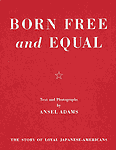|


Teacher
Resources
This
page contains specific resources developed for teachers using
this Exploration.
Entire
Unit | General Childhood Experiences
| Specific Childhood Experiences | Childhood
in Internment Camps |Focus on War
Focusing
Event for Entire Unit:
Analyze
a primary source document:
Distribute
the following document (Shortened
version in Microsoft Word format) (Shortened
version in PDF format) to students and ask them to answer
the following questions:
- Who
wrote this document?
- When
was it written?
- Who
are the residents referred to in the document?
This
is Executive Order 9066 (Full
version in Microsoft Word format) (Full
version in PDF format), issued by Franklin Roosevelt on
February 19, 1942.
Short
Background:
Following
the Japanese attack on Pearl Harbor on December 7, 1941, President
Franklin D. Roosevelt issued this executive order, which permitted
the military to bypass the constitution and the safeguards
for American citizens in the name of national defense.
The
result of this order was the exclusion from certain areas,
and the evacuation and mass incarceration of 120,000 persons
of Japanese ancestry living on the West Coast, most of whom
were U.S. citizens or legal permanent resident aliens. Half
of these people were children.
These
Japanese Americans were forced to relocate to internment camps
surrounded by barbed wire and armed guards for up to 4 years.
Sometimes families were separated into different camps. Many
became ill and died due to inadequate medical care or stress.
Several were killed by military guards.
Brainstorm
with the class the facts they know about World War II.
For
background information, see:
General
Childhood Experiences
Then
and now
- Ask
students to write down the activities they do for a 24 hour
period.
- Using
available resources, brainstorm what daily life was like in
the 1940s during World War II.
- Compare
life in the 1940s with the present.
- Students
could make posters, create multimedia exhibits, or perform skits
describing 1940s life.
Online
Resources:
For
older students
Back
to Top
Specific
Childhood Experiences
For
an integrated lesson with creative writing, ask students to write
about their own childhood experiences.
Here
are some suggested story starters:
- What
are your very earliest childhood memories?
- What
was your favorite toy? Why do you think that toy was special?
- What
was your favorite book? Why?
- What
was your earliest school memory?
- Who
was your first best friend? What has happened to that friendship
in the years that have passed since then?
- Who
was your worst enemy? Why is this memory of that person so vivid?
- What
was your favorite food? What did you eat then that you no longer
eat?
- What
was the biggest trouble you got into as a child? Did you deserve
it?
- What
was your greatest achievement? How did it make you feel? What
influence do you think it has had on your life since?
- Describe
what you did or where you went as a child when you wanted to
feel safe.
Back
to Top
Childhood
in Internment Camps
 |
A
good resource for information about internment camps is
the book Born Free and Equal, a selection of Ansel
Adams's photographs of the Manzanar internment camp which
was published in 1944 by U.S. Camera along with a text by
Adams.
This
book is available on the LIbrary of Congress website:
http://memory.loc.gov/ammem/aamhtml/aamborn.html
|
| In
a letter to his friend Nancy Newhall, the wife of Beaumont
Newhall, curator of photography at the Museum of Modern Art,
Adams wrote: "Through the pictures the reader will be
introduced to perhaps twenty individuals . . . loyal American
citizens who are anxious to get back into the stream of life
and contribute to our victory." |
The
Library of Congress also has an excellent unit plan on Japanese
Internment in their Learning Collections:
http://memory.loc.gov/ammem/ndlpedu/collections/manzanar/history1.html
An
excellent unit plan, The War Relocation Camps of World War II:
When Fear was Stronger than Justice, is online from the National
Park Service:
http://www.cr.nps.gov/nr/twhp/wwwlps/lessons/89manzanar/89manzanar.htm
Back
to Top
Focus
on War
Use
the website, Dr. Seuss Went to War: A Catalog of Political Cartoons,
to analyze political cartoons.
http://orpheus.ucsd.edu/speccoll/dspolitic/
We
associate Dr. Seuss with children's books, but he was active
as a political cartoonist for two years, 1941-1943. He was the
chief editorial cartoonist for the New York newspaper PM and
drew over 400 editorial cartoons.
Back
to Top
|
